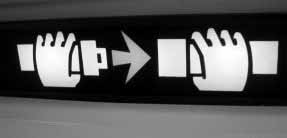On his blog this week, Mike Smith, CCM (and an AMS Fellow) discusses the common air passenger’s frustration  with seat belt warning signs that stay on for hours even when the weather is clear and turbulence-free. But Smith’s post is interesting reading also because it is a uniquely meteorologist‘s frustration with this form of over-warning. He argues that we know enough about clear-air turbulence (and thunderstorm avoidance) that it makes little sense to tie people down to their seats for so long.
with seat belt warning signs that stay on for hours even when the weather is clear and turbulence-free. But Smith’s post is interesting reading also because it is a uniquely meteorologist‘s frustration with this form of over-warning. He argues that we know enough about clear-air turbulence (and thunderstorm avoidance) that it makes little sense to tie people down to their seats for so long.
As we know from experience, most recently the United Airlines flight on July 20th in which two dozen people were injured, the seat belt signs are indeed important. More than 90 percent of all injuries on turbulent flights happen when people don’t buckle up appropriately. But Smith observes,
I fear pilots are — too often — training their passengers not to observe the sign. Fly enough miles with the seat belt sign on but no turbulence and you’re tempted to get up, sign or no sign.
Overuse of the warning sign is well known in aviation circles. From the pilot’s point of view, there’s a lot more to this situation than just meteorology. Some pilots apparently forget the light is on (one critic here says, “I think pilots pay about as much attention to the seatbelt sign as the passengers do”) and in any case airline policies and pilot predilections vary. In the United States, in particular, airlines must deal with liability: passengers frequently sue them when injuries are caused by turbulence. (One wag dubs the seat-belt sign the “anti-litigation switch.”)
Can science overcome this situation? Clear air turbulence has been a topic of research since bomber pilots encountered the jet stream in World War II—the Navy Bureau of Aeronautics’ Project AROWA in the 1950s researched the problem of forecasting clear air turbulence (for example: this paper in the AMS archives). Research on radar techniques for detecting CAT started to take off in the 1970s, and much progress is being made even now (here’s a good example of recent developments in CAT forecasting); it remains an area of intense research and product development.
Ultimately, improved CAT warnings are at the mercy of the confidence that customers (in this case, the pilots) have. Even if pilots do know the latest science or know how to use the latest gadgets, low confidence in new tools can mean excessive warning, which means careless passengers, which in turn means frustrated meteorologists, and an ongoing challenge for the aviation weather community.
This reasoning is exactly why passengers will continue to be injured in sudden CAT encounters. As a passenger, you are not sitting in a static chair, you are strapped into a pressurized tin can hurtling through the sky at better than 200kts in CLEAR AIR, where CLEAR AIR Turbulence occurs. Meaning, CAT cannot be seen by the pilots. No matter how accurately we can predict likely scenarios where CAT may occur, the actual turbulence is still invisible and will occur without warning to the pilots.
To all pasengers: sit down, tighten your belt and don’t think you’re in bar and need your freedom to mingle.
Meredith,
I respectfully disagree. If you will look at my blog, you will see that I have documented several cases where the seat belt sign stayed on the entire flight. I choose not to post on my flights yesterday (BNA-IAH; IAH-ICT) where the signs also stayed on the entire flight. There are times people need to get up: to use the rest room, to hand off a child when parents are seated apart, to get a glass of water when medication must be taken at a specific time. As long as pilots are keeping the sign on for entire flights — regardless of weather conditions — they are “training” passengers to ignore it which is dangerous in and of itself.
We know enough about CAT today that severe turbulence does not occur in summer in clear air well away from thunderstorms. And, yesterday’s flight (except in central Oklahoma near thunderstorms) were very smooth, inspite of the continuously-illuminated seatbelt signs.
Mike